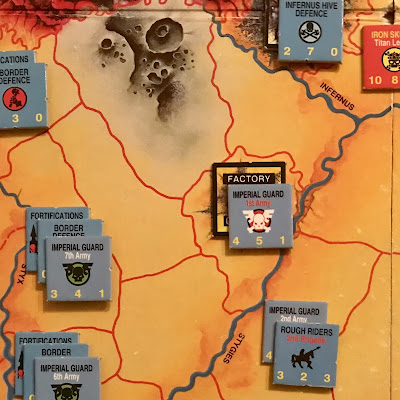Steel Legion 1st Army – The Fighting First
 |
| Hard-drilled, well-led and equipped with the best Armageddon could offer, the 'Fighting First' formed the keystone of Armageddon Secundus' resistance to the ork invasion. @the_steel_legion |
Force Analysis: Imperial Guard 1st Army – The Fighting First
Armageddon's Tithe
By order of Herman von Strab, Planetary Governor
Armour of Steel
 |
| Imperial stratego-ikon |
- Offensive capabilities appreciable
- Defensive capabilities extensive
- Mobility limited
- Numbers estimated at ca. 120,000 primary combatants; 87,000 secondary/support.
- Core of Mechanised Infantry Regiments
- Supplemented by Armour, Artillery, Recon and Engineering specialist support Regiments
- Threat level designation: Secondary
 |
| Grenadiers sweep a bombed-out factory district – such specialist forces were plentiful in the diverse and well-equipped Fighting First @the_steel_legion |
[Strategic Designation] Imperial Guard 1st Army
[Theatre] Armageddon Secundus
[Disposition] Wastelands southeast of the confluence of the Infernus and Stygies Rivers, equidistant between Hives Infernus to the north and Helsreach to the south.
 |
| 1st Army deployment; the Palidus line visible to the west. |
[Notes]
- 16th Mechanised Infantry Regiment – regarded by many as representing the ideals of the Steel Legion.
- 33rd Mechanised Infantry – who adopted the name 'Death Mire Die-hards' following the loss of Armageddon Prime, owing to the number of soldiers recruited from the sacked hive.
- 42nd Special Artillery Regiment – a near-unique force consisting of little more than two dozen Deathstrike Missile Launchers.
- 327th Infantry Regiment – dubbed the 'Steel Talons' by General Shub.
- 404th – the so-called 'Longlost', owing to the tattered Regiment twice reappearing after reports of being destroyed.
 |
| Exemplars of the Steel Legion – Company Command of the 16th Regiment. @the_steel_legion |
'Along with every man jack of 'em here, I'll fight for the memory of lost Volcanus, and to spare Helsreach the same fate – but most of all I'll fight for the chance to piss on the corpse of that alien bastard who led 'em all here, and tell 'em it was Volcanus sent 'im to hell.'
Attributed to Colonel Korvis, 16th Company, 16th Regiment
***
[Commanders] – General Zamael Hands
At just forty-four standard years old, Hands was the youngest officer to be granted Army Command. A native of Death Mire, Hands was a spire-dwelling aristocrat who had inherited his position – but despite the resentful murmurings of older men who envied him his rank, in the face of the orks he quickly proved himself an astute and capable commander.
Not only well-schooled in the theory of warfare at the Collegia Militaris, he had an exacting mindset and a peculiar clarity of vision – a vision, alas, that clashed both with that of his father. Sidelined soon after graduation, and expecting a mediocre role ill-suited to his evident talents, Hands had the peculiar fortune to fall into the orbit of Vilhelm von Strab, a scion of the then-planetary governor and brother to the ruthless future governor Herman von Strab. Soon after Vilhelm's 'suicide', Hands was contacted by his estranged father, who cryptically informed him that he had secured the younger Hands a future off-world, in command of one of the Tithed Regiments.
Whether his father had intended to save Mariusc from the near-inevitable repurcussions of his association with the new Planetary Governor's brother, or was spitefully exiling him, was never revealed to Hands – before he could contact his father, the orks had sacked Death Mire. Lost in grief, Hands would be haunted to his grave by the uncertainty.
Well-regarded by his men, Hands proved himself a virtuoso during hostile environment training in the Fire Wastes with his new Regiment, the 16th. While he was later granted overall Army Command at the first conclave, he maintained strong links with Regiment, and he came to regard the 16th as his praetorians, favouring them by choosing them as his vanguard numerous times during the Armageddon War.
***
[Insignia and appearance] – By virtue of its Tithed status, the First Army is uniformly well-equipped, and almost all of its forces bear Armageddon's familiar tan greatcoats over black fatigues. Advised of the orks' superstitious nature early on, their officers were amongst the first to stylise their rebreathers with the skull device that would become near-universal by the end of the war. While thus not necessarily useful in identification (except for very early battles in the conflict), it is nevertheless notable – if only to help explain why their soldiers affectionately refer to their officers as the 'pearlies', in reference to the visible teeth on their respirators.
 |
| Officer and command Squad of the 16th Regiment – note white on red banner of the 16th, and stylised rebreather. @the_steel_legion |
 |
| Steel Legion Guardswoman of the 404th Regiment. The Army Badge is prominent on the left arm. @the_steel_legion |
The device is universal, appearing on armour, artillery and emplacements – even documentation – as well as the infantry. On turreted vehicles it is typically shown on the front left of the turret, as in the examples below:
Armoured units also frequently bear a tripartite white-red-white stripe on their flanks; though this also varies. The example below – a Leman Russ Exerminator – shows just the central red stripe, a common variant. Note the '808' in the centre, which marks it as part of the 808th Squadron; attached to the 16th Regiment.
 |
| As with the Chimera, the turret number designates the Tank's position within the squadron – the 3rd tank; equivalent to the third platoon. @the_steel_legion |
***



Comments
Post a Comment